Today was meant to be a deep dive into Using Privilege as Leverage, but sometimes, our bodies remind us that rest is non-negotiable. The cold I’ve been pushing through finally took over, and instead of forcing myself through the motions, I chose to honor what my body needed.
But I still showed up.
Because in community, showing up is not just about labor—it’s about reciprocity, trust, and presence. I came on live today for a brief five minutes, not to push through but to acknowledge the space we’ve built together. To affirm that even in rest, we are still committed to each other.
Then, I extended an invitation: do nothing.
Lessons & Community Input
Today’s conversation was not about productivity. It was about permission—permission to stop, to breathe, to be present without an agenda. Some key insights from our brief moment together:
✅ Rest is a communal practice. When one of us chooses rest, it gives others permission to do the same.
✅ Rest does not require justification. You do not have to earn the right to pause.
✅ Dolce far niente—the sweetness of doing nothing—is a radical act. In a culture that glorifies hustle and output, choosing stillness is a form of resistance.
✅ Community is about reciprocity, not obligation. Showing up when you can, and stepping back when you need to, builds trust in ways that grind culture never will.
✅ Flexibility is a necessary part of sustainability. Knowing when to push forward and when to pause ensures that the work remains whole and intact.
Three Key Takeaways on Rest in Community
1. Showing Up is About Presence, Not Performance
Rest does not mean disengagement. It is possible to show up without overextending yourself, just as it is possible to take space without abandoning the collective.
Home Example: A parent communicates their need for rest to their family, modeling boundaries and self-care rather than running on empty.
Self Example: Instead of forcing yourself through work while sick, a person takes a day to rest, trusting that they are still valued even when they are not producing.
Work Example: A team member communicates to colleagues that they need a break, reinforcing that well-being is prioritized over constant availability.
Reflection: Where in your life can you practice presence without performance?
2. Dolce Far Niente: Rest is Not Wasted Time
Stillness is a practice. It is in the quiet moments that our nervous systems reset, our creativity is restored, and our intuition strengthens. Rest is generative.
Home Example: A household sets aside a time for “quiet rest,” where everyone engages in a personal, restorative activity—napping, reading, or simply being still.
Self Example: Experiment with sitting in silence for ten minutes, noticing the discomfort but also the clarity that arises.
Work Example: A team encourages “meeting-free” hours, allowing for focus time and mental recovery instead of constant stimulation.
Reflection: How can you begin integrating intentional stillness into your daily life?
3. Flexibility is Key to Sustainable Liberation Work
Rest is not a sign of inconsistency—it is a sign of sustainability. Rigid expectations burn movements out. We must embrace flexibility if we want to build something that lasts.
Home Example: A family adapts their weekly schedule based on the energy levels and needs of its members, rather than forcing productivity at all costs.
Self Example: A person honors the ebb and flow of their energy, adjusting their commitments accordingly instead of feeling guilty for needing rest.
Work Example: A grassroots organization builds in “pause weeks” for reflection and restoration instead of pushing for non-stop output.
Reflection: Where in your work, activism, or relationships can you introduce more flexibility to support long-term sustainability?
Practice Your Praxis: Actionable Steps for Self, Home, and Work
Self: Give yourself permission to rest without guilt. Set a timer for 15 minutes today where you do absolutely nothing and observe how it feels.
Home: Discuss with loved ones how you can create communal rest rituals—whether it’s a quiet hour, a screen-free evening, or something else.
Work: Advocate for intentional rest practices, whether it’s normalizing breaks, implementing collective time off, or pushing back against grind culture.
Community: Normalize checking in on people’s capacity, not just their commitments. Ask, “How’s your energy today?” before making an ask.
Resources & Next Steps
The Nap Ministry’s Rest as Resistance – A radical exploration of rest as a social justice issue.
The Nap Ministry's Rest Deck: 50 Practices to Resist Grind Culture (Kindle)
Rest for Resistance – A platform centering LGBTQ+ BIPOC mental health and healing.
Season of Self: Dolce Far Niente – Tomorrow’s article diving deeper into how stillness creates abundance.
Tease for Tomorrow’s Exclusive Article: Season of Self – Dolce Far Niente
For so many of us, rest has always felt like something we have to earn. But what if doing nothing was the most radical thing we could do?
Tomorrow’s Season of Self article will dive deep into Dolce Far Niente—the Italian concept of the sweetness of doing nothing. And I have receipts—a 10-year-old photo of me resting, side by side with today’s version of me doing the same. Because the practice of stillness? It’s something I’ve learned to reclaim.
This isn’t just about rest. It’s about releasing the guilt of stillness, rejecting the idea that our worth is tied to productivity, and embracing the abundance that emerges when we simply exist.
Upgrade to paid, for access and if finances are a barrier, email me at Scholarships@DesireeBStephens.com
Conclusion: Rest is a Collective Agreement
We cannot build liberation if we are running on empty.
We cannot sustain community if we do not allow space for pause.
And we cannot truly show up for others if we refuse to show up for ourselves first.
Let today be your invitation to step back, breathe deeply, and embrace the sweetness of doing nothing—not as avoidance, but as an act of radical presence.
Because sometimes, doing nothing is the most important thing you can do.
Preview for Tomorrow: Day 35 - Leveraging Proximity to Power
Privilege is often framed as an individual asset, but what if we shifted the lens? The reality is that privilege only exists within a system that actively subjugates others. There is no true privilege in losing connection to land, culture, language, or community—only proximity to the dominant power structure.
Tomorrow, we’ll explore:
How proximity to whiteness, wealth, or dominant culture can be leveraged—not as personal privilege, but as a tool for dismantling oppressive systems.
Why the concept of “privilege” can sometimes obscure the deeper truth that power only functions through subjugation.
Ways to move beyond privilege discourse and into actionable redistribution, advocacy, and systemic disruption.
Instead of asking, “How privileged am I?” we should be asking, “How can I leverage where I stand to create real, structural change?”
Let’s build this together. See you tomorrow.
In solidarity and liberation,
Desireé B. Stephens, CPS-P
Educator | Counselor | Community Builder
Founder, Make Shi(f)t Happen
Join me tomorrow at 9:30 am EST for my next live video in the app




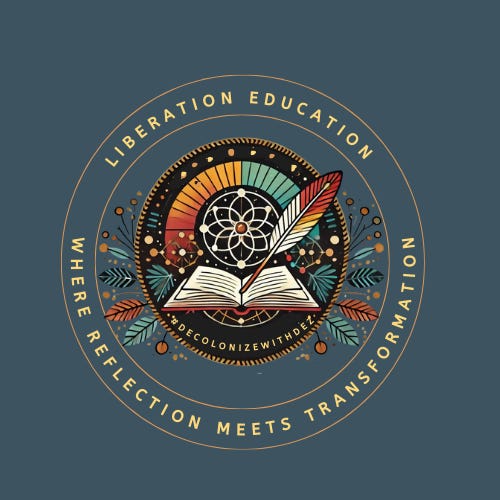

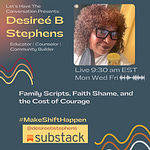


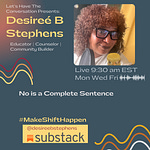

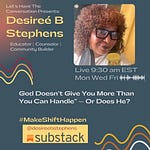
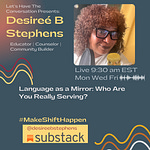
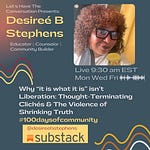
Share this post